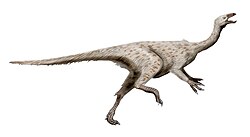Beishanlong: Difference between revisions
No edit summary |
No edit summary |
||
| Line 13: | Line 13: | ||
|familia=Harpymimidae |
|familia=Harpymimidae |
||
|genus='''''Beishanlong''''' |
|genus='''''Beishanlong''''' |
||
|genus_authority = Makovicky ''et al.'', |
|genus_authority = Makovicky ''et al.'', 2009 |
||
| subdivision_ranks = [[Species]] |
| subdivision_ranks = [[Species]] |
||
| subdivision = |
| subdivision = |
||
*''B. grandis'' <small>Makovicky ''et al.'', |
*''B. grandis'' <small>Makovicky ''et al.'', 2009 ([[type species|type]])</small> |
||
}} |
}} |
||
'''''Beishanlong''''' is a [[genus]] of giant [[ornithomimosauria]]n [[dinosaur]] from the [[Early Cretaceous]] of [[China]]. The [[type species]] is ''B. grandis'', described online in 2009 by a team of Chinese and American paleontologists |
'''''Beishanlong''''' is a [[genus]] of giant [[ornithomimosauria]]n [[dinosaur]] from the [[Early Cretaceous]] of [[China]]. The [[type species]] is ''B. grandis'', described online in 2009 by a team of Chinese and American paleontologists. ''Beishanlong'' lived during the [[Aptian]] to [[Albian]] stages, around 100 to 125 million years ago.<ref name="Makovickyetal"/> |
||
==Discovery== |
==Discovery== |
||
| Line 25: | Line 25: | ||
==Classification== |
==Classification== |
||
''Beishanlong'' was closely related to fellow ornithomimosaurian ''[[Harpymimus]]''. Together they formed a [[clade]] that split off from the main ornithomimosaurian branch just below ''[[Garudimimus]]''.<ref name="Makovickyetal">Peter J. Makovicky, Daqing Li, Ke-Qin Gao, Matthew Lewin, Gregory M. Erickson & Mark A. Norell ( |
''Beishanlong'' was closely related to fellow ornithomimosaurian ''[[Harpymimus]]''. Together they formed a [[clade]] that split off from the main ornithomimosaurian branch just below ''[[Garudimimus]]''.<ref name="Makovickyetal">Peter J. Makovicky, Daqing Li, Ke-Qin Gao, Matthew Lewin, Gregory M. Erickson & Mark A. Norell (2009). "A giant ornithomimosaur from the Early Cretaceous of China". ''Proceedings of the Royal Society B: Biological Sciences'', '''277'''(1679): 211-217. {{doi| 10.1098/rspb.2009.0236}}</ref> |
||
==References== |
==References== |
||
Revision as of 17:00, 12 January 2010
| Beishanlong Temporal range: Early Cretaceous
| |
|---|---|

| |
| Scientific classification | |
| Kingdom: | |
| Phylum: | |
| Class: | |
| Superorder: | |
| Order: | |
| Suborder: | |
| Superfamily: | |
| Family: | Harpymimidae
|
| Genus: | Beishanlong Makovicky et al., 2009
|
| Species | |
| |
Beishanlong is a genus of giant ornithomimosaurian dinosaur from the Early Cretaceous of China. The type species is B. grandis, described online in 2009 by a team of Chinese and American paleontologists. Beishanlong lived during the Aptian to Albian stages, around 100 to 125 million years ago.[1]
Discovery
Fossils of a partial skeleton were found in northwestern China, in the province of Gansu. According to the description, Beishanlong "is one of the largest definitive ornithomimosaurs yet described, though histological analysis shows that the holotype individual was still growing at its death."[1]
Classification
Beishanlong was closely related to fellow ornithomimosaurian Harpymimus. Together they formed a clade that split off from the main ornithomimosaurian branch just below Garudimimus.[1]
References
- ^ a b c Peter J. Makovicky, Daqing Li, Ke-Qin Gao, Matthew Lewin, Gregory M. Erickson & Mark A. Norell (2009). "A giant ornithomimosaur from the Early Cretaceous of China". Proceedings of the Royal Society B: Biological Sciences, 277(1679): 211-217. doi:10.1098/rspb.2009.0236
External links
- "Field Museum palaeontologist leads study on two new dinosaurs from China" ScienceCentric.com
